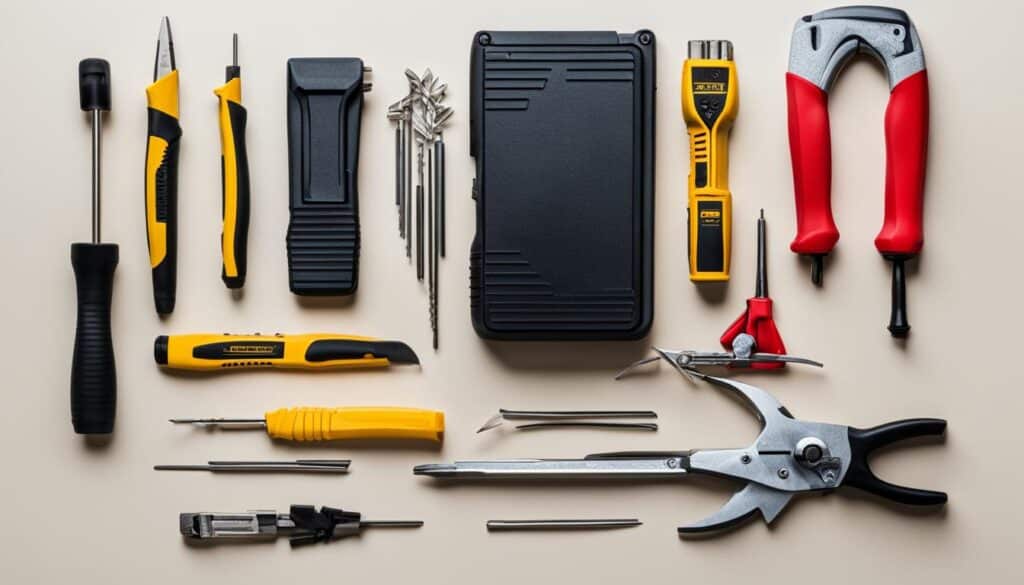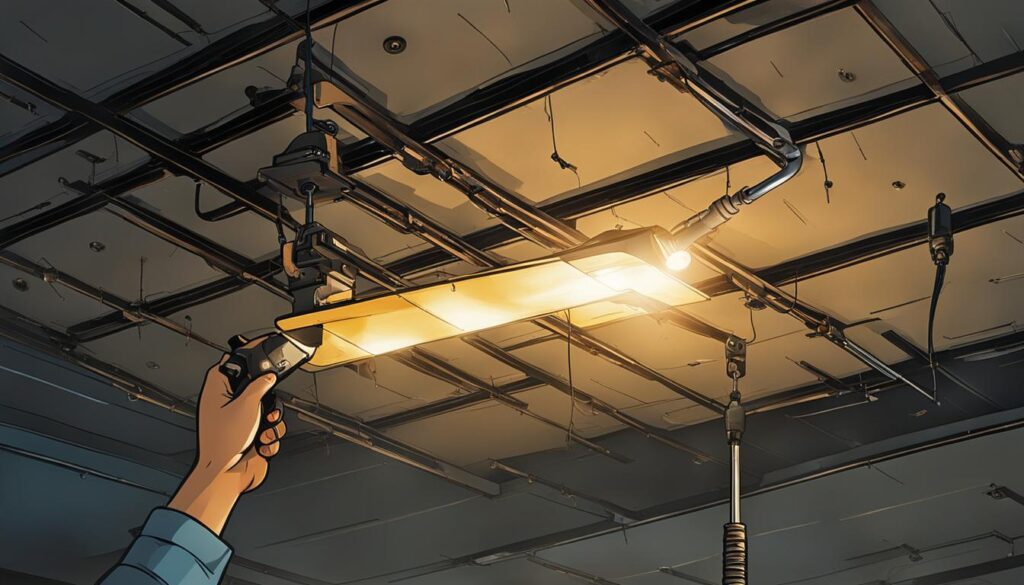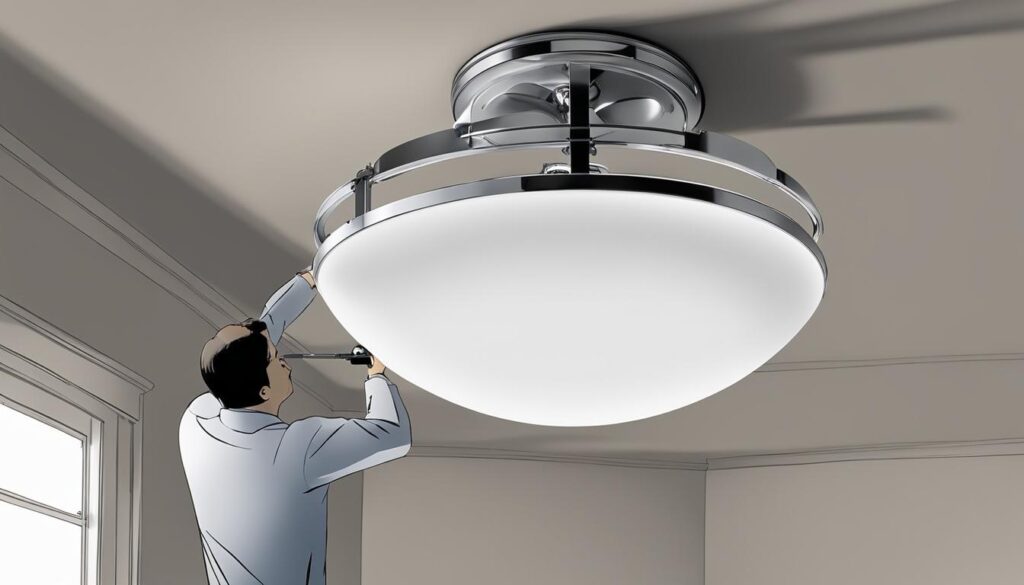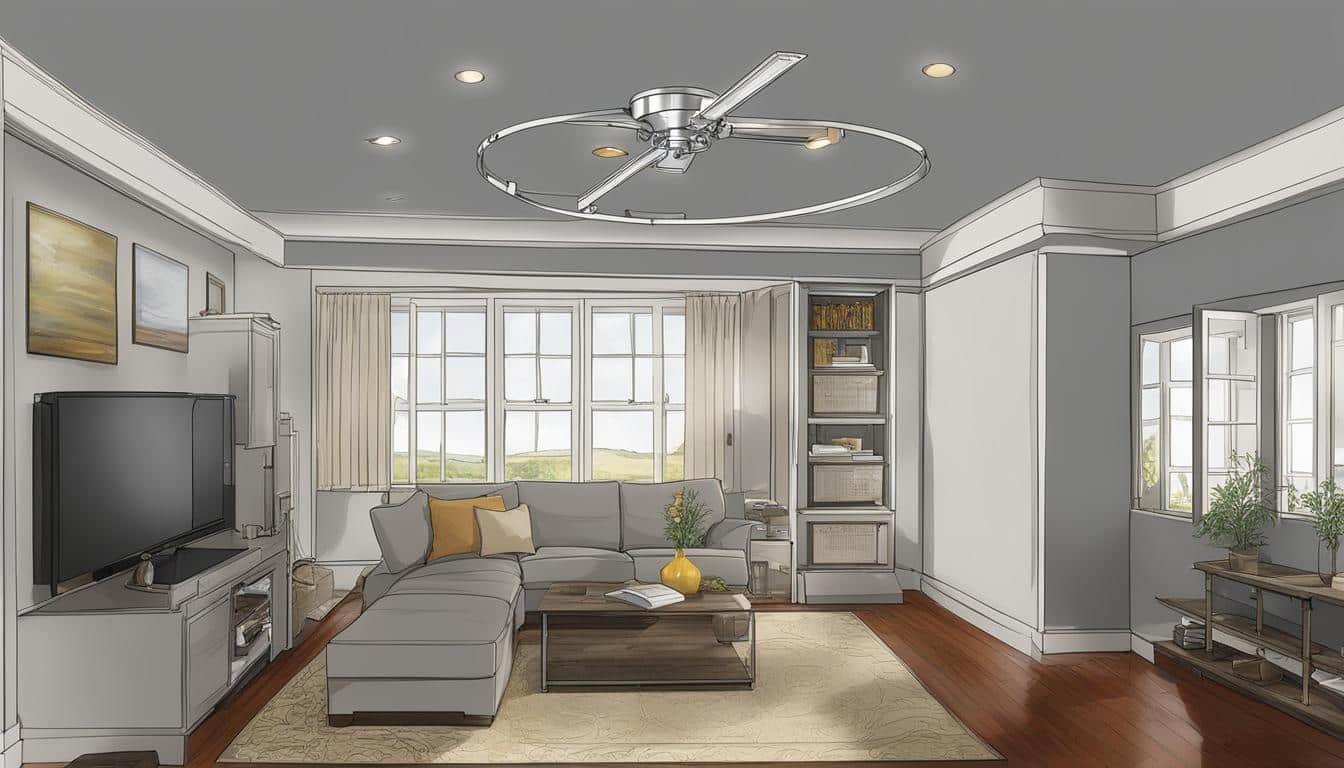Are you ready to enhance the ambiance of your home with an elegant flush mount lighting fixture? This guide is perfect for you! Here, I will teach you how to install a ceiling flush mount lighting fixture with easy-to-follow steps, ensuring a successful DIY installation. Not only will you save money, but you will also have the satisfaction of completing the task yourself. With a focus on safety, I will be sharing crucial ceiling installation tips to make the process enjoyable and efficient.
Key Takeaways:
- Always prioritize safety when working with electricity
- Understand the basics of ceiling flush mount lighting
- Gather essential tools to make the installation process seamless
- Learn the step-by-step process to install flush mount fixtures
- Discover professional tips to achieve a perfect installation
- Enjoy the aesthetic transformation of your room
Understanding the Basics of Ceiling Flush Mount Lighting
Ceiling flush mount lighting is a popular choice for many homeowners due to its clean and sleek look. These lighting fixtures sit directly against the ceiling without any visible gap, providing a seamless and modern appearance. In this section, we will take you through the basics of ceiling flush mount lights and what to expect when installing ceiling lights of this type.
Installation typically involves the following steps:
- Mounting the hardware and electrical wiring
- Securing the fixture base to the ceiling
- Adding light bulbs to the fixture’s sockets
- If applicable, assembling and attaching the shade or cover
Selecting the Right Ceiling Flush Mount Light
Before attempting a lighting fixture installation, it’s important to choose the right light for your space. Consider factors such as room size, ceiling height, and desired light output. This will help determine the size and style of the flush mount light that will best suit your needs.
Working with Electrical Wiring
Always exercise caution when working with electrical wiring. Ensure the power is turned off at the circuit breaker before beginning any installation or maintenance.
When installing a ceiling flush mount light, you will need to connect the wires from the light fixture to the wires in the ceiling junction box. This is typically done by matching the wire colors (hot, neutral, and ground) and securing the connections with wire nuts.
Tips for a Successful Installation
- Take the time to read through the manufacturer’s instructions and gather all tools and materials needed before beginning the installation.
- Make sure the junction box can support the weight of the light fixture before installing it. If necessary, install a new junction box or reinforcement bracket that can carry the fixture’s weight.
- If you’re not confident in your ability to be safe and successful, consider hiring a professional electrician for the job.
| Pros of Ceiling Flush Mount Lights | Cons of Ceiling Flush Mount Lights |
|---|---|
| Space-saving design for homes with low ceilings | May not provide adequate light for high ceilings or large rooms |
| Wide range of styles available, suitable for any decor | Can require more labor-intensive installation if replacing a different type of fixture |
| Energy-efficient options available, including LED technology | Some designs are harder to clean and maintain due to their close proximity to the ceiling |
Now that you have a solid understanding of the basics of ceiling flush mount lighting, you’re well-prepared to tackle your installation project. Remember, safety should always be your top priority, so don’t hesitate to consult a professional if you have any doubts or concerns along the way.
Essential Tools Needed for Installing Ceiling Lights
The success of your lighting fixture installation depends on having the right tools on hand. Before getting started, gather the essential tools to ensure a smooth and efficient step by step process.
Gathering Your Tools
A well-prepared DIY enthusiast will have these tools needed for installing ceiling lights:
- Flat-head screwdriver
- Phillips screwdriver
- Small adjustable wrench
Additionally, a power screwdriver can be incredibly helpful for speeding up the installation process and reducing hand fatigue.
Pro tip: Double-check your lighting fixture’s manual to see if there are any additional tools required specific to your chosen model.

Now that you’ve gathered your tools, you’re ready to tackle the lighting fixture installation with confidence. Just remember to work diligently, follow the step by step guide, and practice safety throughout the process.
Turning Off Electricity: Safety First!
Before diving into your DIY ceiling flush mount installation project, it’s crucial to prioritize safety. One of the most critical safety precautions when working with electrical wiring is turning off the electricity to the room where you’ll be installing the lighting fixture. In this section, we’ll cover the necessary steps to follow to ensure a safe installation process for your ceiling flush mount light.
https://www.youtube.com/watch?v=fUMzFeFGVh4
To turn off the electricity, first, locate the room’s circuit breaker within your home’s electrical panel. Depending on the design of your panel, the breaker may be labeled with the room’s name, or you may need to reference a circuit map or chart. Once you find the correct breaker, switch it off to cut power to the room where you’ll be working.
Remember, always double-check that the power is off by trying the light switch before beginning the installation.
With the power turned off, you can now confidently proceed to install your flush mount lighting fixture, knowing you’ve taken the appropriate safety precautions.
- Locate the room’s circuit breaker within the electrical panel
- Switch off the breaker
- Double-check that the power is off by trying the light switch
Always exercise caution when working with electricity, as it can pose a risk if not handled properly. It’s essential to take these steps when performing any DIY electrical installation project to protect yourself and your home from potential hazards.
Removing the Old Lighting Fixture
Before installing your new ceiling flush mount lighting fixture, you’ll first need to remove the existing lighting fixture. By following this step-by-step process, you’ll efficiently dismantle the old unit while properly handling the electrical wiring, ensuring a seamless transition to the new fixture.

Step-by-Step Process to Dismantle the Old Unit
- Disconnect the cover or globe: Start by carefully loosening and removing the cover or globe of the lighting fixture to expose the bulb and wiring.
- Remove the light bulb(s): Unscrew and safely dispose of the bulb(s) to avoid any potential hazards during the removal process. Remember to be cautious as bulbs may be hot if recently turned off.
- Detach the fixture from the ceiling: Unscrew and remove any mounting hardware holding the fixture to the ceiling.
- Handle the electrical wiring: Once the fixture is detached from the ceiling, take extra caution when unscrewing the wire nuts and separating the wires to avoid any electrical hazards. Always make sure the power is turned off before handling any wiring.
- Remove the baseplate: If there is an existing base plate or mounting bracket, unscrew and remove it to completely clear the area for your new ceiling flush mount installation.
By following these ceiling installation tips, you’ll safely and efficiently remove the old lighting fixture, properly handling the electrical wiring. This will create a clean workspace, preparing the area for your new ceiling flush mount lighting fixture installation.
Preparing the Area for Your Ceiling Flush Mount Installation
Now that you’ve successfully removed the old fixture, it’s time to prepare the area for your new ceiling flush mount installation. This process involves clearing out the outlet box and ensuring the space is ready for the new lighting fixture.
First, make sure to remove any debris or dust from the outlet box and its surrounding area. This will not only provide a clean surface for working but also ensure proper electrical connections during the installation.
Follow these simple steps to ensure your workspace is well-prepared:
- Inspect the outlet box to make sure it is securely attached to the ceiling and in good condition.
- Confirm that the existing wires are not frayed or damaged. If you encounter any issues, consult a professional electrician before proceeding with the installation.
- If your flush mount fixture requires more than the standard black, white, and ground wires, make sure the necessary wiring is in place and ready for connection.
- Take note of the mounting holes in the outlet box and ensure they align with the mounting hardware of your new lighting fixture.
Remember, preparing the area for your ceiling flush mount installation is crucial in ensuring a seamless and successful installation process.
Once the area is clear and your electrical wiring is in good condition, you’re ready to proceed with the next steps of installing your new ceiling flush mount lighting fixture. The upcoming installation process will require the proper tools, mounting hardware, and wire connections in order to achieve the desired results and create an impressive focal point in your room.
Connecting the Mounting Hardware and Wires
Once you have prepared the installation area, it’s time to connect the mounting hardware and wires. Here are the steps to follow:
- Attach the crossbar to the outlet box using the provided screws. Ensure it is securely fastened and level.
- Connect the ground wire according to local electrical codes. This may involve attaching it to the crossbar, or directly to the ground screw on the flush mount base.
- Using wire nuts, connect the fixture’s wires to the house wiring. Typically, you will join the black (or red) wire from the fixture to the black (or red) wire from the house and the white wire from the fixture to the white wire from the house.
- Tightly wrap each wire connection with electrical tape to secure it and prevent exposure.
Adhering to these guidelines will ensure a safe and secure DIY ceiling flush mount installation.

Before moving forward with the installation, make sure your wire connections are tight by giving each a gentle tug. Loose connections can lead to issues with your lighting fixture.
In addition to connecting mounting hardware and wires, it is essential to ensure you are working with appropriate electrical wiring for your fixture. While connecting the wires, you may encounter common household wire types, such as:
| Wire Type | Description |
|---|---|
| Black or Red | Hot/live wire, carries electricity from the electrical panel to the fixture |
| White | Neutral wire, completes the electrical circuit, carries electricity back to the panel |
| Green or Bare | Ground wire, provides a path for electricity to flow toward the ground in case of a fault |
Following these guidelines for connecting mounting hardware and managing the electrical wiring will ensure a successful and safe DIY ceiling flush mount installation. In the next section, we will discuss the process of mounting the fixture’s base to the ceiling.
Mounting the Base to the Ceiling
Mounting the fixture correctly ensures both safety and aesthetic appeal. It is essential to secure the fixture base properly for a professional finish and to avoid any potential issues in the future. In this section, we will discuss some professional tips for installing ceiling lights and guide you through the process of mounting the base to the ceiling.
Ensuring a Secure and Level Fit
Before you start mounting the base to the ceiling, ensure that you have properly connected the mounting hardware and wires as mentioned in the previous section. Once you have completed this step, you are ready to begin the process of mounting the fixture.
- Place the fixture’s base over the outlet box, aligning it with the mounting screws. Ensure that all the connected wires are within the outlet box and not pinched between the base and ceiling.
- Insert the mounting screws into the appropriate holes and twist them into place. Use a screwdriver to tighten the screws, making sure they are secure but not overly tightened. Over-tightening can potentially damage the base or the ceiling.
- Check that the base is level. If you notice any unevenness, you may need to adjust the screws or mounting hardware. Ensuring a level fit is crucial for achieving a professional and attractive finish.
Pro Tip: Investing in a small handheld level or using a leveling app on your smartphone can be very helpful in ensuring that the fixture stays level throughout the installation process.
With the fixture’s base securely mounted to the ceiling, you can now move on to the final steps of installing your ceiling flush mount lighting fixture, including adding light bulbs and attaching the shade or cover.
Adding Light Bulbs to the Fixture
Now that your flush mount lighting fixture is securely installed, it’s time to add light bulbs to make it functional and complete. Selecting the right bulb is crucial, as it will determine the brightness, color, warmth, and efficiency of your lighting fixture. I strongly recommend referring to your fixture’s specifications for the correct size and wattage to ensure the best performance.
Selecting the Right Bulb for Your Fixture
When selecting bulbs, it’s important to consider factors such as:
- Type of bulb: LED, CFL, or incandescent
- Wattage
- Color temperature
- Dimmability
Before selecting your bulbs, verify the fixture’s compatibility with your preferred bulb type and avoid surpassing the maximum wattage allowed. Exceeding this limit may result in permanent damage to your lighting fixture or potential fire hazards. Remember, you are not obligated to use the maximum wattage if you prefer a dimmer ambiance for your space.

Once you have chosen the right bulbs, you’re ready to install them into the fixture’s sockets. If your lighting fixture requires multiple bulbs, follow the installation instructions carefully, ensuring each bulb is correctly fitted and secured. Remember to turn off the electricity supply while installing the bulbs to guarantee your safety.
“Proper bulb selection and installation is an important part of the lighting fixture installation process. Always ensure the bulbs you choose are compatible with your fixture’s specifications and follow safety guidelines to avoid potential hazards.”
| Bulb Type | Advantages | Disadvantages |
|---|---|---|
| LED (Light Emitting Diode) | Long-lasting, energy-efficient, lower heat emission | Higher initial cost |
| CFL (Compact Fluorescent Light) | Energy-efficient, lasts longer than incandescent bulbs | Contains small amounts of mercury, may be slow to reach full brightness |
| Incandescent | Low initial cost, traditional warm light | Less energy-efficient, shorter lifespan |
With the correct bulbs installed and your ceiling flush mount lighting fixture fully assembled, you’re ready to enjoy the beautiful and effective illumination it provides in your space. Congratulations on your successful lighting fixture installation!
Attaching and Securing the Shade or Cover
Once you have installed the base and added the light bulbs to your ceiling flush mount fixture, the final step is to attach and secure the shade or cover. By attaching the fixture shade or cover, you will not only enhance the visual appeal of the fixture, but also ensure that the light is evenly distributed throughout the room. 
Before you start attaching the fixture shade or cover, make sure to carefully read the provided installation instructions. This is crucial to ensure that the shade or cover properly aligns with the base and that the decorative finish looks seamless.
- Identify the provided assembly pieces needed for attaching the shade or cover to the fixture.
- Hold the shade or cover up to the fixture’s base and carefully align it with the base’s mounting holes or brackets.
- Depending on the type of fixture, you may need to use a combination of screws, nuts, and/or brackets to secure the cover in place. Always utilize the hardware provided by the manufacturer.
- Ensure that the shade or cover is level and evenly spaced around the fixture’s base.
- Tighten any visible hardware to ensure a snug and secure fit. Avoid over-tightening, as this could cause damage to the shade or cover.
In some cases, the shade or cover may feature a simple twist-on design, eliminating the need for additional hardware. However, if your fixture has an integrated shade or cover, this step may not be applicable.
Pro tip: When attaching the shade or cover, take note of any gaps or uneven areas between the shade and the base. Small adjustments to the mounting hardware can help ensure a seamless and professional-looking finish.
With the shade or cover securely attached, you can now admire the completed installation of your new ceiling flush mount lighting fixture. By following this step-by-step guide, you have successfully upgraded your home’s lighting with a beautiful and practical DIY ceiling flush mount installation.
Conclusion: Enjoying Your Newly Installed Ceiling Lighting
Now that you’ve successfully completed the installation of your ceiling flush mount lighting fixture, it’s time to enjoy the fruits of your labor. This DIY project not only adds a touch of elegance to your space but also saves you money by installing it yourself. The enjoyment of your new ceiling lighting begins as soon as you switch it on and admire the fresh aesthetic it brings to your home.
Your installation success serves as a testament to your DIY skills and dedication to home improvement. With a basic understanding of lighting fixture installation, you’ve tackled an important task that usually requires a professional electrician. Eager to take on future lighting fixture projects, you now possess the essential lighting fixture installation tips needed to beautify your living spaces even further.
As you bask in the warm glow of your new ceiling flush mount lighting fixture, remember to maintain it to ensure longevity and excellent performance. Clean it periodically, following the manufacturer’s guidelines, and make certain to replace any burnt-out bulbs promptly. Congratulations on a job well done – your newly installed ceiling lighting not only elevates your home’s look but also brings you satisfaction from a successful DIY project.
FAQ
What tools do I need for installing a ceiling flush mount lighting fixture?
The essential tools needed include flat-head and Phillips screwdrivers, a small adjustable wrench, and optionally, a power screwdriver for efficiency during installation.
How do I confirm the power is off before starting the installation process?
Ensure the power is off by first locating the room’s circuit breaker and switching it off. Next, double-check the power is off by using the light switch before beginning the installation.
What are the steps to remove an old lighting fixture?
To remove an old lighting fixture, first, disconnect the cover or globe. Then, detach the fixture and carefully unscrew the wire nuts and separate the wires. Lastly, remove the existing base plate to clear the area.
How do I connect the fixture’s wires to the house wiring?
Begin by attaching the crossbar to the outlet box using the provided screws and connecting the ground wire according to local electrical codes. Connect the fixture’s wires to the house wiring using wire nuts to secure the connections.
What type of bulbs should I use for my new ceiling flush mount lighting fixture?
Choose the correct size and wattage of light bulbs as recommended by the fixture’s specifications. If the fixture requires multiple bulbs, install them according to the instructions without exceeding the maximum wattage.
How do I attach the shade or cover of my fixture?
If your fixture includes a shade or cover, attach it using the provided assembly pieces. Secure it in place with the necessary hardware and make sure it aligns properly with the base for a seamless decorative finish.

